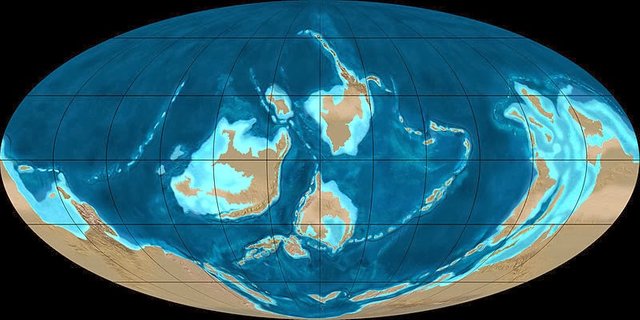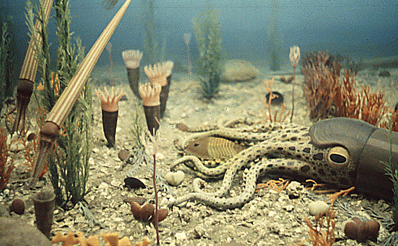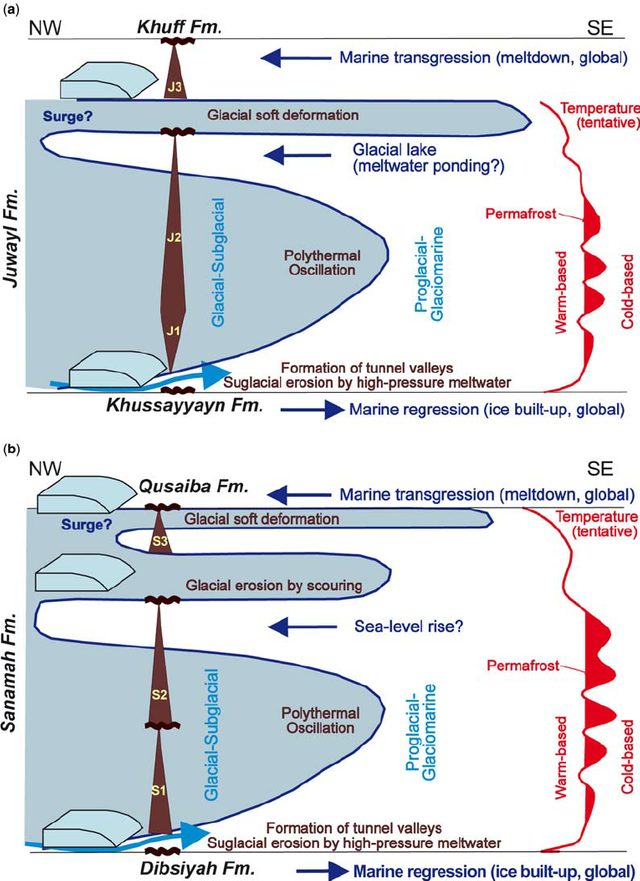Mother Earth Isn't Always so Nice: Death in the Seas 455 Million Years Ago

img src: Josephine Wall
Mother Earth is often depicted as a kind and loving Mom. A sweet and caring figure who gave birth to us and life on Earth. One that, if left alone, nature would be beautiful and lovely and stable. This idea probably stems from the Disneyication of nature starting no later than the movie Bambi. People who lived closer to nature knew she was less than kind at times. Honestly, its far, far worse than that: Mother Nature likes to kill her children. Not just in ones or twos through predators hunting. Not just in the thousands through a "small" natural disasters. Mother Nature likes to, now and then, massacre vast swathes of the ecosystem. World wide. Simultaneously. These are the mass extinctions.
There are six very large mass extinctions that are acknowledged. These are ones that have profoundly changed the ecosystems of the world. They changed the course of biology here on Earth and had massive impacts. There are probably more of significant note. There are two more I can think of as the science works its way forward would count, but one of those will take a long time before it is declared one way or another. The Big Six are the Holocene, Cretaceous/Paleogene, Triassic/Jurassic, End Permian, Devonian and Ordovician. The End Ediacaran and Francevillian probably ought to be included but the latter has still has decades of work before it is accepted. If it is, it will be the most profound of them all. Today, however, we will be talking about the Ordovician Mass Extinction.

src: Geology Page
The Ordovician Period stretched from 485 million years ago to 443 million years ago, spanning 42 million years. It bridged between the Cambrian and the Silurian. The world was dominated by an Antarctic continent and would end up with an ice age, the Hirnantion Glaciation. This would be one of the big drivers for the mass extinction.
While life went through its weird experiments during the Cambrian, the Ordovician had a huge radiation of the successful forms from the Cambrian. Gone were most of the weirdest Cambrian critters. However, life diversified greatly. The oceanic ecosystems would be dominated by suspension feeders, animals living and eating like modern corals and sea anemones but were not. Most common were the sea lilies. Life mostly was confined to the ocean, but the first ventures out onto land were underway by primitive plants and arthropods (insects, arachnids and their exoskeleton wearing cousins). While there were vertebrates in the oceans, none as yet had ventured onto land and the tetrapods - animals with four legs like amphibians, mammals and birds - were a long ways off still.
Animals that were common were the famous trilobites, numerous cephalopods, the free swimming vertebrate cousin conodonts, and the afore mentioned sea lilies.

Img src: PLOS
While life would diversify and even start invading the land, Mother Nature seems to have 'decided' life needed a reset and in her grumpiness would cause the Ordivician Mass Extinction. Mother Nature is just a concept, an anthropomorphization of nature, but the effects would be the same as if an angry god had destroyed the world, or at least partially. Up to 60% of all genera of marine life were wiped out. 85% of all species in the ocean were wiped out as well.
A genus (multiple are called genera) is a group of closely related species. Like the horse, zebra, donkey, etc. are all part of the genus Equus. There are seven species currently within Equus that are currently living (or as they say 'extant'). When a genus is wiped out, that means a type of animal will not exist anymore. If you wiped out all Equus, then there would be no more horse-like animals on Earth. However, if you wiped out just say all but the donkeys, there is a chance the descendants of the donkeys could evolve bodies like the forms of horse through parallel evolution. Animals that look the same but are not and are a reevolution of that body type are called 'Elvis taxa.' This is named after the Elvis impersonators: they look like him but are definitely NOT him. Most of the time, these impersonators come from closely related animals or plants. Convergent evolution is good, but so good that a dolphin would never be mistaken for a shark in the fossil record.
The extinction wiped out many types of animal and precluded their descendants from participating in the ecosystems in the future. That 60% of all genera were wiped out was devastating, making the Ordovician Mass Extinction one of the worst. If the mass extinction was so devastating, why did it happen? Are we in danger of that sort of extinction again?

img src: Research Gate
We are not exactly under threat from the same mechanism for the mass extinction currently. It was an odd and possibly unique combination of a glaciation - ice age - and anoxic ocean. Because life was confined to the ocean, this made life that much more vulnerable to the environmental problems. And both of these problems - the glaciation and anoxic ocean - happened at once, causing the mass extinction. But why were they problems?
During a glaciation, especially one we would call an ice age like the recent Pleistocene, the early Permian and the Hirnantian during the Ordovician, a lot of the sea water gets locked up inside giant glaciers. These glaciers cover vast amounts of the dry land and even stretch into the sea. This causes the sea level to drop, often times almost all the way out to the edge of the continent shelf. Most life lives in the shallow waters in the ocean and if the glaciers suck up too much water, much of the shallow water habitat is destroyed. This will, by itself, cause extinctions. However, not a mass extinction because life, as they say, finds a way. It takes more than just the glaciation to do life in on that scale. Unfortunately, life kind of provided the way for the other part necessary to harm itself.
During the Ordovician, life became very productive. It produced more organic matter than the decomposers of the ocean could deal with. This caused the oxygen levels in the ocean to be depleted. This produced an anoxic ocean, anoxic meaning 'without oxygen.' You can see this problem is smaller lakes today, when they get stinky, it is often because the algae are growing so much and dying, the oxygen in the water gets used up faster than it can be replaced. Animals that breathe in the water need oxygen (with a few, very very rare exceptions). So when an animal ends up in those waters like that and breathes through water, it will almost certainly die.
When an ocean becomes anoxic, as it did in the Ordovician, normally it is the bottom waters, deep at the bottom of the sea, that become anoxic first and it slowly climbs upwards towards the surface. The surface ocean often remains with a fair amount of oxygen, but it can be very, very shallow before it becomes unbreathable for animals. The oceans have been anoxic many, many times through the last 550 million years, but they didn't constantly have mass extinctions or we would not be here today. Life would have, at least oxygen breathing, complex life, would have eventually been wiped out. However, in the Ordovician, the anoxic ocean ocean helped cause a major, if not the second largest known mass extinctions.

image src: Outer Places
Why?
That would be because the combination of a massive ice age and anoxic oceans was enough to be devastating for life. Life survived, but it was badly beaten and in some ways barely survived. Keep in mind the glaciations reduced the shallow waters to very small areas, what would be called refugia. Those areas would be too small for most animals to survive it. Going deeper in the water was not possible, since the deeper waters were toxic without oxygen. Think of it as the Hunger Games for those small areas where life could survive. To make matters worse, an ice age was not a constant time of giant glaciers. There would be interglacials where the glaciers would melt back. In the Pleistocene, the most recent ice age, these would last ten to twenty thousand years. The water would run out into the sea and the sea levels rise. At first, this seems great! A respite from the tiny confines of the refugia sounds great for life to reproduce and spread...the problem is the meltwaters allow the anoxic bottom waters to spread upwards faster and inwards into the shallows much faster than life can handle. Think of it as finally being able to breathe deeply, only to be hit with a chemical weapon. The glaciers would return and life would be forced back into its tiny pockets. Then the cycle would repeat. Freeze, retreat, melt, get poisoned.
How long is lasted up for debate. Some feel the extinctions took tens of millions of years. Others think there was a smaller time frame. However, in the end, it doesn't matter as far as life is concerned: Mother Nature brutally wiped out vast numbers and types of life. Life that in forms and species would never have the like again.
However, it would all come to an end. The Silurian Period would begin and life would have something of a respite. There would be minor mass extinctions, but no major ones until the Devonian. And then, as a researcher in mass extinctions would say, there would be one darn (he used a different word) thing after another. However, for 67 million years, a time a bit longer since the dinosaurs were wiped out, life survived.
Mother Nature did all of this without people being involved. We would not exist, nothing remotely like us would exist, for another 440 million years. Mother Nature is not all Bambi and Disney. In fact, she is rather the contrary and has more in common with Baba Yaga than current personifications. Now and again, she winds up and destroys the world. All without our help. Mom might be beautiful, but she is exceedingly vicious.
Ordovician
https://en.wikipedia.org/wiki/Ordovician
Ordovician Radiation:
https://en.wikipedia.org/wiki/Ordovician_radiation
Ordovician–Silurian extinction events
https://en.wikipedia.org/wiki/Ordovician%E2%80%93Silurian_extinction_events
Changes in marine productivity and redox conditions during the Late Ordovician Hirnantian glaciation
https://www.sciencedirect.com/science/article/pii/S0031018214006075#f0005
UNM researcher finds a cause of mass extinctions
http://www.dailylobo.com/article/2018/09/mass-extinction-oxygen-oceans
Palaeozoic glacial depositional environments of SW Saudi Arabia: Process and product
https://www.researchgate.net/publication/259502678_Palaeozoic_glacial_depositional_environments_of_SW_Saudi_Arabia_Process_and_product
You are always welcome to join us and get more recognition for your posts. You can find more information about geopolis here or join our Discord server.